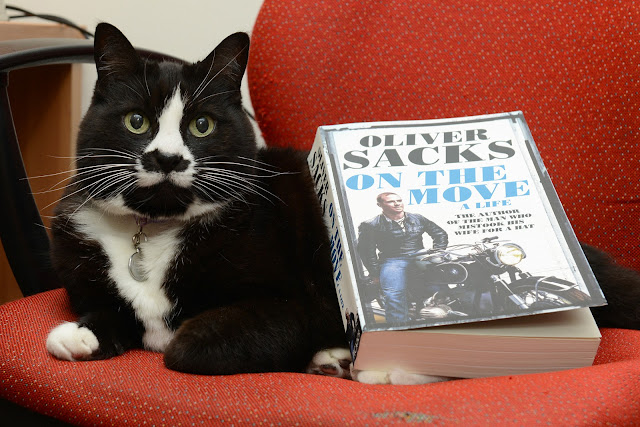 |
| Michael likes nothing more than siting next to a human hot water bottle whilst a book (preferably a big one) is being read. |
Winter weekends are perfect for reading, and if you’re
going to be sitting around reading and generating body heat, SAT recommends
that you keep a cat warm whilst doing so. And if you’re looking for something
to read and interested in science, the humanities or both, you can’t really go
past Oliver Sacks.
He is one of the most popular medical writers of our
time. Recently he learned he has metastatic cancer (he
reflected about his diagnosis and morality here).
I was fortunate enough to see Dr Sacks speak in Sydney in
1998 (gasp!), and he came across as a very shy, very English, introverted
person with a huge wealth of knowledge. It was only after reading his last
autobiography, “On the Move: A Life”, that I learned he was an avid
motorcyclist, a body builder and one of many medical doctors of his era who
experimented (rather a lot) with illicit drugs. He had a really interesting version of work:life balance and sustained some amazing injuries and heartbreaking losses (I don't want to give too much away here).
What does this have to do about a companion animal blog, you ask? Well, Sacks is more into plants than
animals, but there is a touching passage about how he met Puss, his only feline
companion.
“Early in the summer of 1994, I was adopted by a stray cat. I got back from the city one evening, and there she was, sitting sedately on my porch. I went into the house and brought out a saucer of milk; she lapped thirstily. Then she looked at me, a look that said, “Thanks buddy, but I’m hungry, too.”
I refilled the saucer and came back with a piece of fish, and this sealed an unspoken but clear convenant: she would stay with me, if we could arrange a way of living together. I found a basket for her and put it on a table on my front porch, and the next morning, I was happy to see, she was still there. I gave her more fish, left a bowl of milk for her, and took off for work. I waved good-bye to her; I think she understood that I would be back.
That evening, she was there awaiting me; indeed, she greeted me by purring, arching her back, and rubbing herself against my leg. I felt oddly touched when she did this. After the cat had eaten, I settled myself, as I liked to, on a sofa by the porch window, to eat my own dinner. The cat jumped up on her table outside and watched me as I ate.
When I got back the next evening, I put her fish out on the floor again, but this time, for some reason, she would not eat it. When I put the fish on the table she jumped up, but it was only when I settled myself on the sofa by the window that the cat, lying parallel to me, started to eat her supper as I ate mine. So we ate together, in synchrony. I found this ritual, which was to be repeated every evening, remarkable. I think we both had a feeling of companionship – which one might expect with a dog but rarely with a cat. The cat liked to be with me, she would even, after a few days, walk down to the beach with me and sit next to me on a bench there.
I do not know what she did in the day, though once she brought me a small bird and I realised she must have been hunting, as cats do. But whenever I was in the house, she would be on the porch. I was charmed and fascinated by this interspecies relationship. Was this how man and dog had met a hundred thousand years ago?” pp285-286.
Puss, as Sacks named her, was subsequently rehomed with
some friends because of his travel commitments. I think he underestimates how
social cats are. There are, for example, plenty of companion cats who prefer to
be watched when eating.
One thing I liked about Dr Sacks is that - at least in
his opinion piece - he doesn’t really distinguish between humans and animals.
In reflecting on his (now precarious) existence, Sacks wrote that he was
grateful that:
“Above all, I have been a sentient being, a thinking animal, on this beautiful planet, and that in itself has been an enormous privilege and adventure.”
